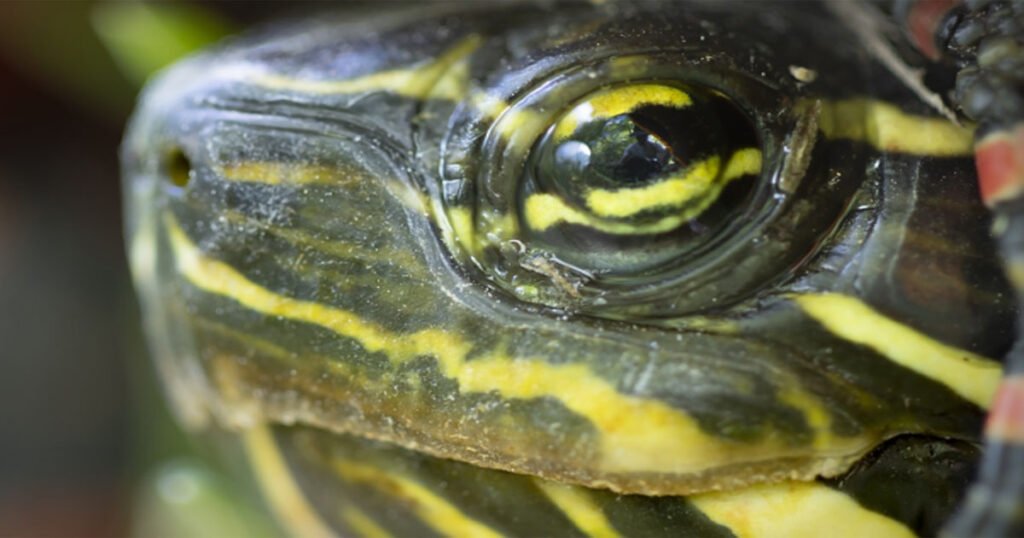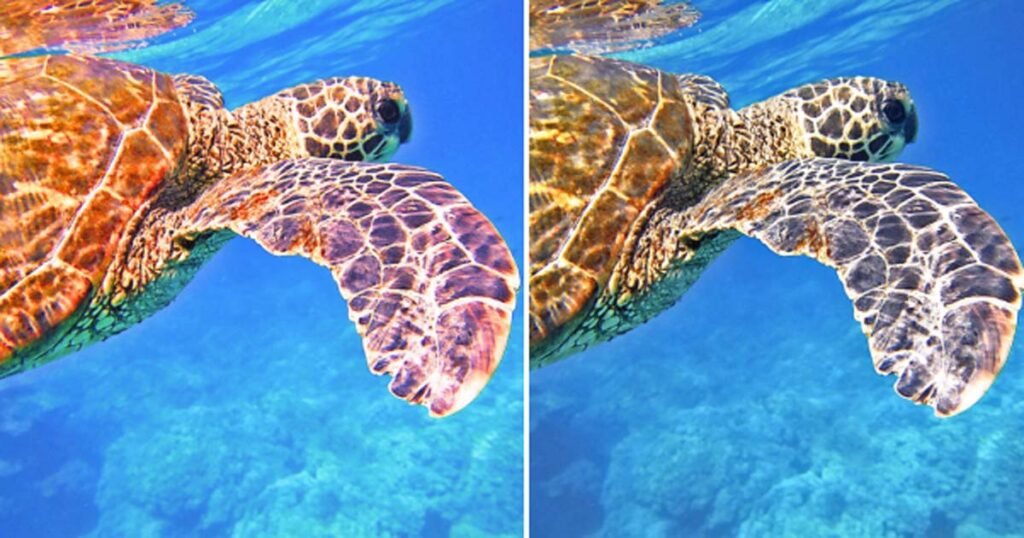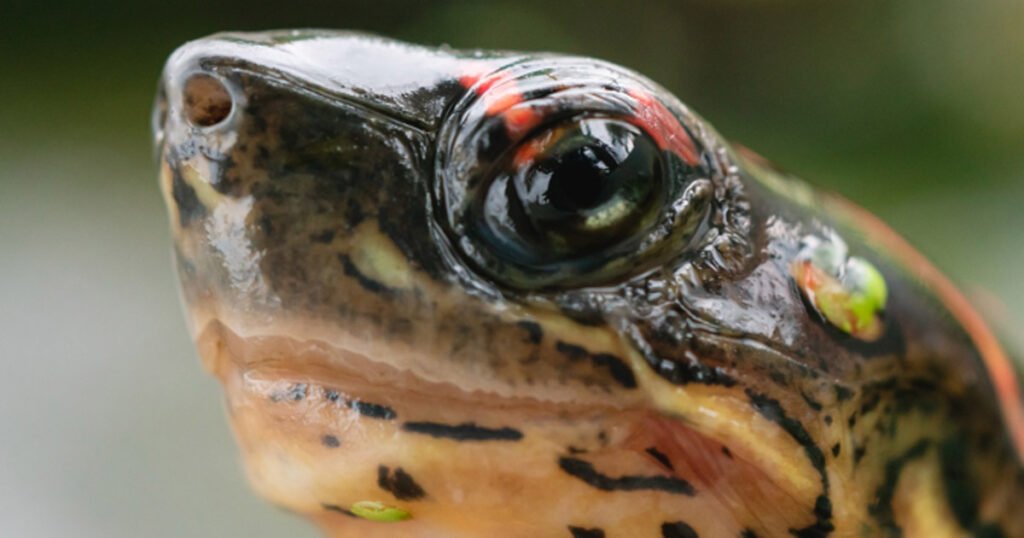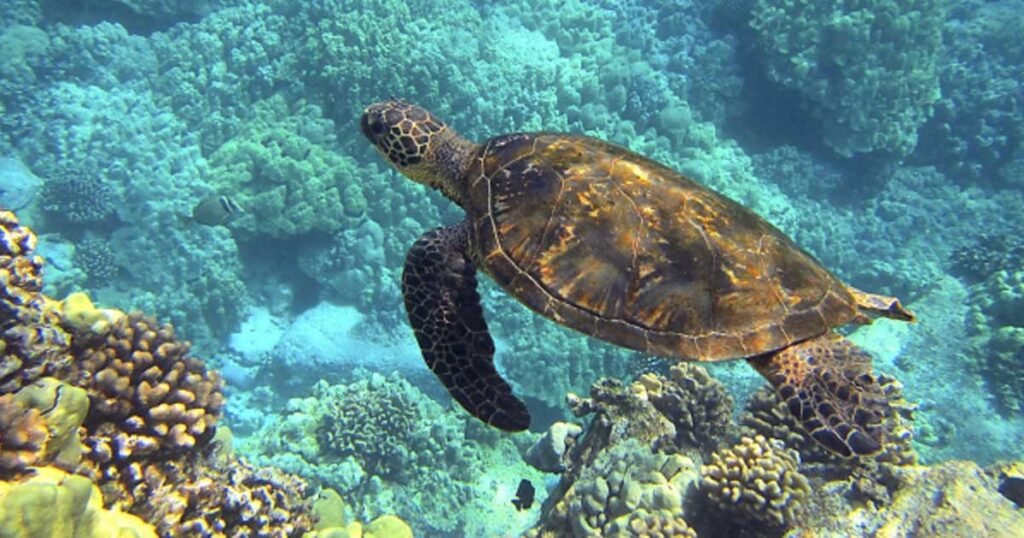Can turtles see color? Have you ever wondered about this question? Turtles’ captivating world goes beyond their slow-moving nature and gets into their vision. Many animals can see colors, and it helps them understand signals from other animals and the world around them. Turtles are loved as pets by adults and kids alike these days.
They are not only beautiful and fun to watch but also fascinating to study. Studies show turtles aren’t color-blind like many people believe. Turtles can see more shades of red than most animals, even more than humans.
While turtles’ vision was mysterious before, recent research indicates they perceive a spectrum of colors. In this exploration, we’ll unravel the fascinating mystery of Can turtles see color? Or how do turtles see? Let’s find out the answers to these questions about their visual perception in different environments.
Can Turtles See Color?

Yes, turtles can see colors. Turtles are not only capable of seeing colors, but they have tetrachromatic color vision, allowing them to perceive more colors than humans. The presence of the CYP2J19 gene contributes to their enhanced color vision. Contrary to earlier beliefs, recent studies indicate that turtles can see a broader spectrum of colors than us. In the next section, we will explore some of these colors and how turtles respond to them.
Turtle Vision: How They See
The Red Advantage: CYP2J19 Gene
Turtles possess an exceptional advantage in their CYP2J19 gene, often referred to as the “red gene.” This genetic trait enables them to perceive an extensive range of red shades, surpassing human capabilities. This heightened sensitivity to red hues may play a crucial role in their daily activities. It helps turtles locate food, identify mates, and navigate their surroundings with precision. The evolution of this gene shows how turtles have fine-tuned their sensory perceptions for survival.
Color Receptors
Cones in ActionAlmost all animals have cones in their eyes that help them see color. Humans possess three types of cones, each responding to specific color ranges. Turtles, potentially equipped with more cone types, enjoy a broader spectrum of colors. The presence of the CYP2J19 gene enhances turtles’ ability to perceive various shades of red. It helps them have a richer visual experience compared to humans. It gives turtles a heightened sensitivity to color variation and allows them to navigate their environment.
Visual Difference Between Human & Turtle Vision: A Comparative Look

Below there is a comparison of human and turtle vision showing how enhanced color perception impacts their eyesight. Different turtles have different color receptors, which introduce new colors and influence how they see them. However, for this CYP2J19 gene, turtles see anything a bit more reddish than humans.
In the left image, you will notice the image has a more red tone, this is how things look in turtle vision. On the right side, is the vision human sees.
Evolutionary Insights: Why turtles see colors better than humans

Thousands of years ago, humans and turtles shared an extensive spectrum of colors. However, as evolution unfolded, humans underwent changes that led to the loss of certain genes responsible for the perception of these additional colors. Turtles, on the other hand, carried these gene mutations, providing them with a unique color vision advantage.
The adaptive advantage of Extra Colors
For turtles, the ability to see more colors is crucial to their survival. These extra hues become invaluable tools in identifying potential predators and locating food sources within their diverse environments. The turtle maintains these color receptors in the wild, unlike humans, whose lifestyles have shifted to communal living and agriculture.
Human Evolution: A Trade-off for Survival
As humans transitioned from hunting and foraging to settled agricultural practices, the need for colors diminished. Evolutionarily, humans reallocated resources to enhance other aspects of survival. This led to the gradual loss of the ability to see the broad spectrum that turtles still enjoy today.
The exact timeline of this evolutionary divergence remains unclear. The fact that humans and turtles perceive colors similarly highlights how different species have adapted to changing environments over time.
The Twilight Palette: Turtles’ Unique Vision in Low Light
How turtles see in the dark or in low light, let’s see more –
Seeing Red in the Dark
While turtles share a similar ability to see in the dark with humans, their vision is distinguished by an enhanced perception of red hues. In a side-by-side comparison of human and turtle vision in low light, the subtleties of this extra perception become apparent, especially in environments with residual light.
Humans vs. Turtles Night Vision
When humans enter a dark room, it takes approximately 30 minutes for our eyes to fully adjust to the lack of light. Similarly, turtles need accommodation in low-light conditions. However, the additional colors in their spectrum don’t significantly influence this process.
Turtles and Tapetum Lucidum: A Peek into Nocturnal Vision
Contrary to some nocturnal animals, turtles lack a tapetum lucidum, a reflective membrane behind the eye that enhances night vision. The absence of a tapetum lucidum means turtles do not exhibit the characteristic eye glow seen in animals equipped with this adaptation.
How Turtles’ See In Aquatic World Adventure

It doesn’t matter whether turtles are exploring the land or swimming in water, they have the same visual perception. They can transition seamlessly between environments underwater because they have consistent color perception.
Murky Waters Impact
While turtles maintain consistent vision, water clarity plays a pivotal role. In cloudy and unclear waters, turtles may face visibility limitations. This challenge is not exclusive to turtles; even human creatures renowned for exceptional vision, such as hawks, or eagles face difficulties in smog or fog.
Turtle Tears: Protective Secret
Turtles possess a remarkable defense mechanism against dirty water hindrances and tears. Not emotional distress tears, but specialized tears designed to keep their eyes hydrated. They use these tears to shield their eyes from the salt and bacteria in the water, so they can see underwater.
Turtle tears keep eyes hydrated and protect them from waterborne elements. As a natural defense mechanism for unobstructed underwater vision, turtles use their tears to navigate and thrive in diverse environments.
What Colors Turtles Like?
Turtles seem to have a preference for certain colors, like blue, orange, and yellow. Sea turtles, in particular, prefer yellow and blue-green light, bordering on ultraviolet. While the reasons behind this attraction remain unclear, observations from both pet owners and researchers suggest a particular fondness. This unique visual preference helps them detect bioluminescent prey. But it also exposes them to risks, especially in high-light areas.
The mystery surrounding why turtles favor specific colors is an area that continues to puzzle scientists. It’s hard to understand turtle color perception, but behavioral observations offer some insights. Whether they’re in captivity or the wild, turtles are attracted to blue, orange, and yellow things.
FAQ
What colors can turtles see?
Turtles see a vivid world of colors—blues, greens, and reds. They even catch near-ultraviolet, blue-green, and yellow light. It allows them to detect bioluminescent prey and navigate with celestial elegance.
How many colors can turtles see?
There isn’t a precise color count list for turtles, but they’re not color-blind. They perceive an extra color, likely favoring red and yellow. Sea turtles excel at underwater vision while being shortsighted in the air. Their world includes near-ultraviolet, violet, blue-green, and yellow hues.
Read More: Can Turtles Eat Kale
The Takeaway
And there you have it, a colorful look into turtle vision—answering the age-old query, can turtles see color? It turns out our shelled friends don’t just live in black and white. A gene called CYP2J19 allows turtles to reveal a spectrum of colors that surpasses our own.
So, the next time you catch your turtle gazing into the distance, remember that they might be amazed at a palette beyond our perception. For turtles, color isn’t just a visual delight; it’s a language, a signal, and a unique lens through which to see the world. Keep those colors vivid, and let your turtles swim through the vibrant canvas of their colorful world!
